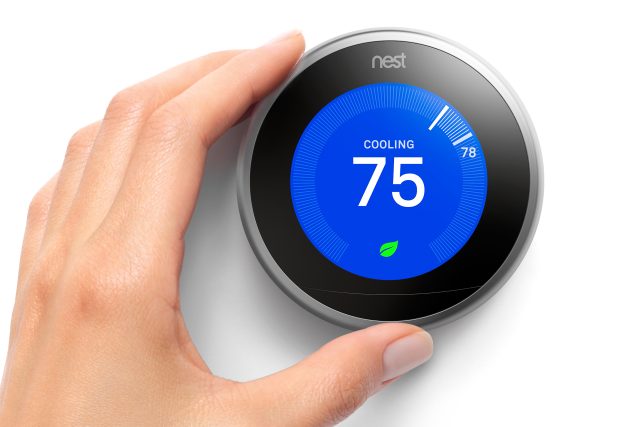
A new Google Nest thermostat has hit the FCC. Droid-Life was the first to spot this listing on the government's site. The listing is in confidential mode, so it's sparse on details, but the details we do have are kind of weird. We think it has air gesture controls.
First, the RF exposure report lists the device as a "thermostat" and says it has 802.11n Wi-Fi and Bluetooth, which all seems pretty normal. Then, it lists the device with a "60GHz Transmitter," which has not been on a previous Nest Thermostat. One possible use for a 60GHz transmitter is "WiGig," a 60GHz form of Wi-Fi that can hit 7Gbps. High-speed data transfers don't really seem appropriate for a thermostat, though, so the other more likely possibility is Project Soli, Google's air gesture system that was first commercialized late last year on the Pixel 4.
Project Soli is an air gesture system that Google has been developing for some time. It's a compact radar system-on-a-chip, and Google has FCC approval to use Soli in the 57- to 64-GHz frequency band. The original sales pitch for Soli was that, by blasting your hand with 60Ghz and capturing the returning signal, Soli could detect "sub-millimeter motions of your fingers," which would enable very fine gesture control. It was possible to pinch your thumb and forefinger together for a button press or rub the two fingers together to spin a dial. Soli was originally envisioned for devices without large touchscreens, like speakers or smartwatches. A Nest thermostat would likely fit into that description, since it doesn't have a touchscreen and instead relies on a spin-able scroll wheel that doubles as the outside body of the thermostat.
-
The original Soli gestures from 2015. None of these work on the Pixel 4.
-
These gestures were enabled by this original Project Soli chip, as shown at Google I/O 2015. Note that there are six antennas.
-
In 2016 Google shrank the chip and power usage, while still keeping the six antennas.
-
The Pixel 4 chip only gets four antennas. Most likely there is one for transmitting radar and three for receiving.
-
Soli was demoed in a smartwatch, which makes sense given the small touchscreen.
-
There was also a smart speaker demo, which, again makes sense when you don't have a huge touchscreen.
Of course, the Pixel 4 version of Project Soli was a mess, and shrinking down the experimental chip to make it fit into a smartphone meant killing a lot of the "sub-millimeter" precision that was promised. Instead of moving your fingers around, the Pixel 4 needed big, arm-waving gestures to detect anything, and the functionality was very redundant considering a smartphone already has a huge touchscreen on the front. Perhaps a thermostat, which is a lot thicker than a smartphone and doesn't have to worry about battery life, can use a bigger, more precise chip.
To date, Google has never really taken a swing at designing a Nest Thermostat. Google bought Nest in 2014 for 3.2 billion, but Nest spent several years being run as an independent company under the Google (and later Alphabet) umbrellas. The current flagship thermostat, the 3rd-gen Nest, was released in 2015, and the cheaper Nest E launched in 2017. Nest stopped being a standalone company and merged into Google in 2018. By Google I/O 2019, Nest the company was truly dead, and "Nest" became a Google sub-brand. Nest and Google still have a lot of confusing overlap, like competing smart home apps, and it seems like eventually all the Nest products will need to be replaced by Google versions.
Google might be in charge now, but there's rarely a good reason to release an updated version of a thermostat. It's just a thermostat! It doesn't ever need faster processors or upgraded connectivity, so you've got to have some other excuse for spinning up a new piece of hardware. Using Google logic, Project Soli air gestures seem like a good enough reason to build a Google version of the Nest Thermostat. I'm not sure anyone actually wants to wave their hand around at a thermostat, but we'll see what Google's eventual sales pitch is.
Technology - Latest - Google News
September 12, 2020 at 01:51AM
https://ift.tt/2ZwU8E1
New Google Nest Thermostat hits the FCC, possibly with air gesture controls - Ars Technica
Technology - Latest - Google News
https://ift.tt/2AaD5dD
Shoes Man Tutorial
Pos News Update
Meme Update
Korean Entertainment News
Japan News Update
Bagikan Berita Ini
















0 Response to "New Google Nest Thermostat hits the FCC, possibly with air gesture controls - Ars Technica"
Post a Comment